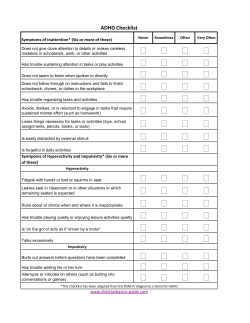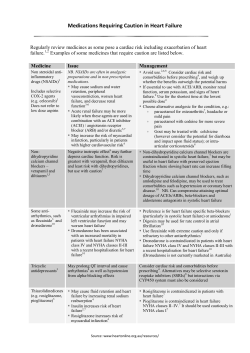
A D U
ADULT ADHD SUMMARY AND RECOMMENDATIONS • • • • • • • • • • • • Between 30 and 70 percent of children with ADHD have continued symptoms into adulthood. DSM-IV criteria for ADHD requires a history that ADHD symptoms were present by age seven, though it has been suggested this be extended to age twelve. Hyperactivity is less overt in adults than children; adults more often appear hectic and disorganized. Utah criteria were developed to identify ADHD in adults: Hyperactivity and poor concentration Two of the following: o Affective lability o Hot temper o Inability to complete tasks and disorganization o Stress Intolerance o Impulsivity There is no gold standard diagnostic test for ADHD in adults. Diagnosis is based on the clinical interview; assessment of mental status, memory, and cognitive testing with distraction; and medical evaluation including neurologic examination and thyroid function studies. The differential diagnosis for ADHD includes depression, bipolar disorder, generalized anxiety, substance abuse, and learning disability; some of these may be comorbid diagnoses. Medical conditions with symptoms overlapping ADHD include hyperthyroidism, seizure disorder, lead toxicity, and adverse effects from medications or head injury. Stimulants are the most commonly used medications in adults with ADHD, but response rates may be lower than in children. Stimulants differ in pharmacokinetics but have similar efficacy. Blood pressure and heart rate should be closely monitored when initiating stimulant treatment in adults. Stimulants should be avoided in patients with history of or increased risk for substance abuse. Secondary amine tricyclic antidepressants (TCAs) with activity through norepinephrine pathways (eg desipramine and nortriptyline) and bupropion have been effective as monotherapy for ADHD, or in combination with stimulants. An electrocardiogram should be obtained before initiating TCA therapy, and after achieving target dose. Atomoxetine is the only approved medication for the treatment of ADHD that is not controlled under the Controlled Substance Act in the US. There are case reports of severe liver injury, and other adverse effects include gastrointestinal symptoms and sleep disturbance. Adult ADHD is a chronic, life-long condition with onset in childhood; continued pharmacotherapy throughout adulthood is usually indicated. For the patient with no contraindications, long-term stimulant use is a reasonable choice. For the patient with a history of substance abuse, a tricyclic antidepressant or atomoxetine is preferred. Bupropion is a reasonable alternative for the patient with cardiac or other medical contraindications to stimulants or TCAs. Effexor is also a second-line treatment (off label use). Clear functional goals and measures of improvement should be established before initiation of treatment and monitored during treatment to evaluate efficacy of medications (ie Pt can read for 30mins; pt can complete work assignments in a timely manner etc…) Instruction in time management and organizational skills is also helpful. Planning and organization can be improved by encouraging regular list making and use of computerized schedulers. Reducing distractions may include having a clutter free desktop, a carrel style desk, or a windowless office. University of Washington © 2010 COMMON PSYCHOTROPICS Bupropion (Wellbutrin, Budeprion)Dosing Information: Start: IR-100 mg bid X 3d then ↑ to 100 mg tid if tolerated; SR-150 mg qam X 3d then ↑ to 150 mg bid if tolerated; XL-150 mg qam X 3d, then ↑ to 300 mg qam if tolerated. Therapeutic dosing range: 300-450 mg/d. General Information: Wellbutrin has a novel mechanism of action (it is similar in structure to amphetamines). It is FDA approved for depression and SAD. Its T ½ is 21 hr. Common side effects include agitation, anxiety, insomnia, dry mouth, nausea, pharyngitis, & weight loss. It is contraindicated in seizure disorder because it decreases seizure threshold. It is stimulating, not good for treating anxiety disorders and is a second line TX for ADHD. The immediate release and the sustained release (preferable to use) forms are on the formulary. Atomoxetine (Strattera) Dosage: Attention deficit hyperactivity disorder: 40 mg/day ORALLY; increase after a minimum of 3 days to a target dose of approximately 80 mg/day; MAX dosage of 100 mg/day may be considered after 2 to 4 additional weeks in patients who have not achieved adequate response on lower doses. General Information: Common side effects: Abdominal pain, Decrease in appetite, Nausea, Xerostomia, and Insomnia. Serious side effects: Cardiovascular: ( Myocardial infarction, Prolonged QT interval, Sudden cardiac death) , Seizure (adults, 0.1% ), Psychiatric: Mania, Psychotic disorder, Suicidal thoughts (pediatrics, 0.4% ), Reproductive: Priapism (rare) and Angioedema. Monitoring: palpitations, near syncope, or syncope; may be indicative of a cardiac condition, complete family and patient cardiovascular history, detailed physical examination and medication history to detect cardiac conditions associated with SCD , blood pressure and heart rate; baseline and at 1 to 3 months, every 6 to 12 months thereafter and hepatic function tests if signs of liver dysfunction. Dextroamphetamine and amphetamine (Adderall): Dosage Information: Treatment of ADHD in adults. Initial dosing is 5 mg once or twice daily with increase daily dose in 5 mg increments at weekly intervals until optimal response is obtained. Titrate to lowest effective individualized dose. Administer first dose as soon as awake; use intervals of 4-6 hours between additional doses. To avoid insomnia, last daily dose should be administered no less than 6 hours before retiring. Usual maximum dose: 40 mg/day given in 1-3 divided doses per day. Monitoring parameters: CNS activity, blood pressure, pulse; appetite; signs/symptoms of tolerance or dependence. General Info: Common side effects: Insomnia, headache, appetite decreased , abdominal pain, dry mouth and weight loss. Rare but life-threatening: MI, seizure, stroke, sudden death. Black Box warnings: Cardiovascular events: These products should be avoided in the patients with known serious structural cardiac abnormalities, cardiomyopathy, serious heart rhythm abnormalities, or other serious cardiac problems that could increase the risk of sudden death that these conditions alone carry. Patients should be carefully evaluated for cardiac disease prior to initiation of therapy. Drug abuse: Potential for drug dependency exists; prolonged use may lead to drug dependency. Use is contraindicated in patients with history of ethanol or drug abuse. Prescriptions should be written for the smallest quantity consistent with good patient care to minimize possibility of overdose. Other cautions: hypertension, pre-existing psychosis or bipolar, seizure disorder and Tourette's syndrome. PREGNANCY RISK FACTOR — C; Use during pregnancy may lead to increased risk of premature delivery and low birth weight. Infants may experience symptoms of withdrawal. Teratogenic effects were effects were reported when taken during the 1st trimester. LACTATION — Enters breast milk/contraindicated. Generic available on GAU formulary Methylphenidate (Concerta): Dosing Instructions: Patients not currently taking methylphenidate: Initial dose: 18-36 mg once daily in the morning Dose adjustment: May increase dose in increments of 18 mg; dose may be adjusted at weekly intervals. Maximum dose should not exceed 2 mg/kg/day or 54 mg/day in children 6-12 years or 72 mg/day in children 13-17 years. Monitoring parameters: CNS activity, blood pressure, pulse; appetite; signs/symptoms of tolerance or dependence. General Info: Common side effects: Insomnia, headache, appetite decreased , abdominal pain, dry mouth and weight loss. Rare but lifethreatening: MI, seizure, stroke, sudden death. Black Box warnings: Cardiovascular events: These products should be avoided in the patients with known serious structural cardiac abnormalities, cardiomyopathy, serious heart rhythm abnormalities, or other serious cardiac problems that could increase the risk of sudden death that these conditions alone carry. Patients should be carefully evaluated for cardiac disease prior to initiation of therapy. Drug abuse: Potential for drug dependency exists; prolonged use may lead to drug dependency. Use is contraindicated in patients with history of ethanol or drug abuse. Prescriptions should be written for the smallest quantity consistent with good patient care to minimize possibility of overdose. Other cautions: hypertension, preexisting psychosis or bipolar, seizure disorder and Tourette's syndrome. Visual disturbance: Difficulty in accommodation and blurred vision has been reported with the use of stimulants. University of Washington © 2010
© Copyright 2025





















